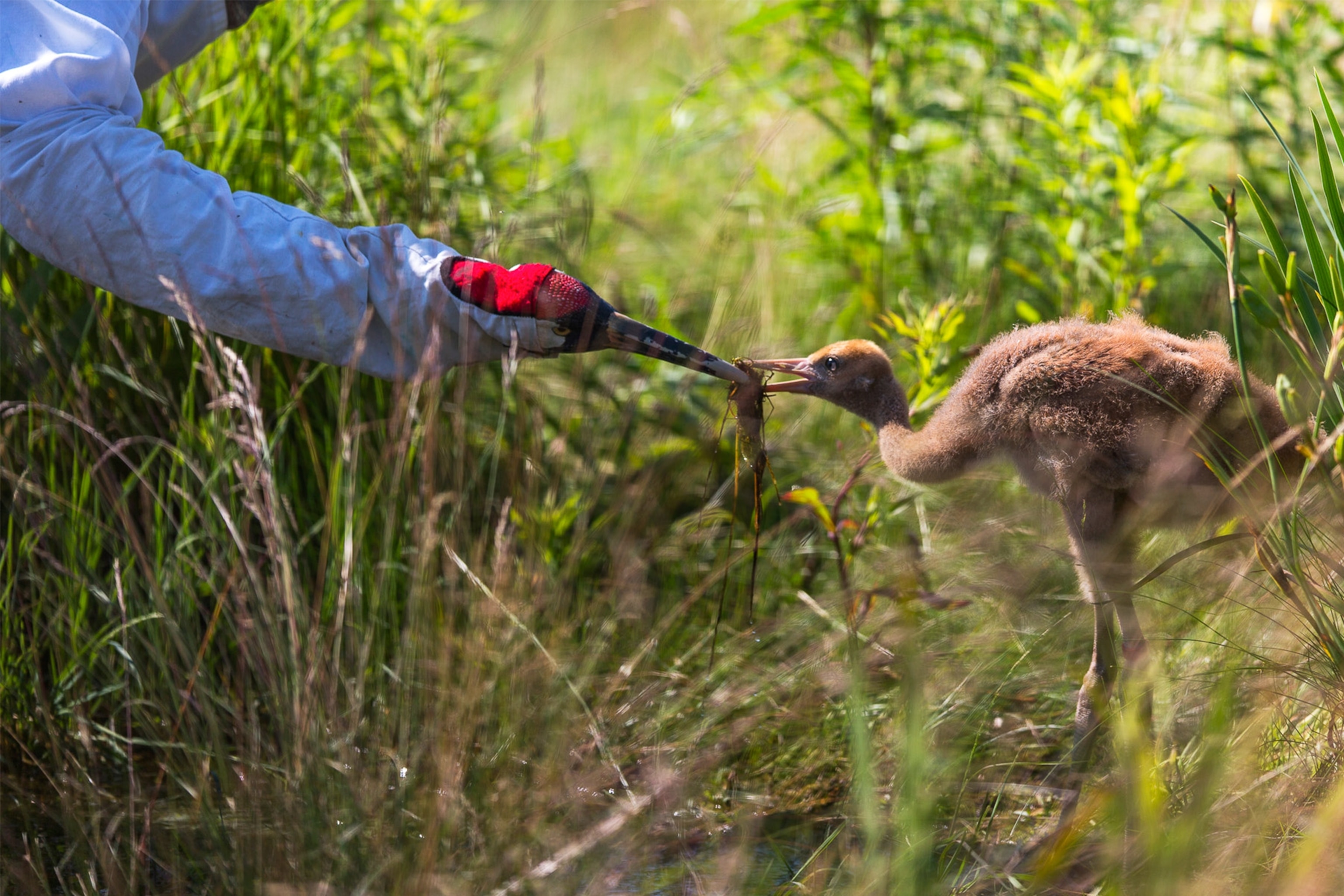
Why Scientists Wear Animal Costumes—It's Not Just for Halloween
From whooping cranes to pandas, people masquerade as animals to get closer to their research subjects.
It's Halloween year-round for some wildlife researchers, who don costumes to get closer to the animals they're working to save.
From giant pandas to whooping cranes to even crocodiles, many scientists disguise themselves as animals to collect valuable data that they wouldn't be able to get, well, in their human skins.
Sometimes, their costume goes beyond just putting on clothes. Caregivers at the China Research and Conservation Center for the Giant Pandaat the Wolong Nature Reserve in Sichuan Province, for instance, dress in furry giant panda costumes—and then sprinkle themselves with panda poop and pee.
"That's to mask the human smell," said Andrea Muller of Pandas International, a Colorado-based organization that supports the Chinese panda center.
By wearing panda suits during the cubs' medical checkups, staff minimize the animals' stress and human attachment, Muller said. (See "Is Breeding Pandas in Captivity Worth It?")
The young animals spend two years with their mothers before they are able to be released into the wild. That's not easy, though—so far the center has released just three panda cubs, including a female named Xue Xue earlier this month. Their eventual goal is to boost the wild population of 1,600 pandas.
Spirit Bears
On an island north of Vancouver, Canada, lives a tiny group of so-called spirit bears, black bears with a genetic variation that gives them white fur. (See pictures of the spirit bear in National Geographic magazine.)
Biologist Tom Reimchen, of the University of Victoria in British Columbia, wondered if white fur gives spirit bears an advantage in fishing pink, chum, and coho salmon. So a few years ago, he and his students draped themselves in either white or black fabric, waded into a fishing hole, and recorded how the salmon behaved.
Their hypothesis was correct: "We saw a shift in salmon response depending on what we were wearing," said Reimchen. "During the day, the fish were less evasive to the white costumes, which is what we saw watching the salmon interacting with real bears." (See video: "Searching for the Spirit Bear.")
The study, published in the Biological Journal of the Linnean Society in 2009, suggests that white fur may help bears be more successful at fishing, possibly because salmon don't recognize the relatively rare animals as predators.
Note to Orvis: Maybe you should start selling Casper costumes.
Whooping Cranes
At the International Crane Foundation, based in Baraboo, Wisconsin, dressing like a ghost isn't just for Halloween. (See "Halloween Costume Pictures: Spooky Styles a Century Ago.")
Staff drape themselves in white to hide their bodies and use a bird-shaped hand puppet to interact with baby whooping cranes hatched at the foundation.

"We try to replicate what actual parents do," said Kim Boardman, the assistant curator of birds. "The puppet offers natural food, catches grasshoppers, and teaches chicks to forage."
Chicks hatched in May at the center are released into the wild in October. (See "Wise Old Whooping Cranes Teach Young How to Migrate.")
In the 1940s, only about 20 whooping cranes lived in the wild, due to widespread hunting and habitat loss. Today there are over 400, thanks to hunting bans, habitat protection—and yes, puppetry.
Moose
The problem: Scientists needed to know how wild moose in the Yellowstone area responded to odors of predators, such as wolves, that were recolonizing the region after being hunted nearly to extinction. But first, they had to place predator poop near the normally skittish moose.
The solution: Wear a moose suit and casually drop it near the large mammals, said Joel Berger, a wildlife biologist at the Wildlife Conservation Society.
Berger and colleagues' research, published in Science in 2001, found that moose had indeed forgotten that they should run at the whiff of wolf. Research since has shown that the animals learned quickly—or became dinner.
Crocodiles
Speaking of poop, hippopotamuses make so much that it affects the water quality in Kenya's Mara River.
"There [are] over 4,000 hippos, and we figure they contribute about 36 tons every day," said Amanda Subalusky, a Ph.D. student in ecology and evolutionary biology at Yale University in New Haven, Connecticut.
Subalusky, who studies water quality, wanted to know if all that hippo poop kills fish when the river is flooded. The trouble is, getting good water samples means risking being squashed by one or several four-ton charging hippos.
Enter her team's customized remote-controlled boat, which is disguised with a lifelike Nile crocodile head and fully loaded with water sensors and sonar that record the river's depth, oxygen levels, and conductivity.
Hippos and crocs ignore each other, so the disguise worked: The team successfully steered the 2-foot-long (0.6 meter long) craft through several hippo swimming holes.
As for whether the hippo poop is deadly, that's still under investigation: The team is analyzing data and will launch again in January.
It may sound like a crappy job, but someone has to do it.
Follow Karen de Seve on Twitter.





